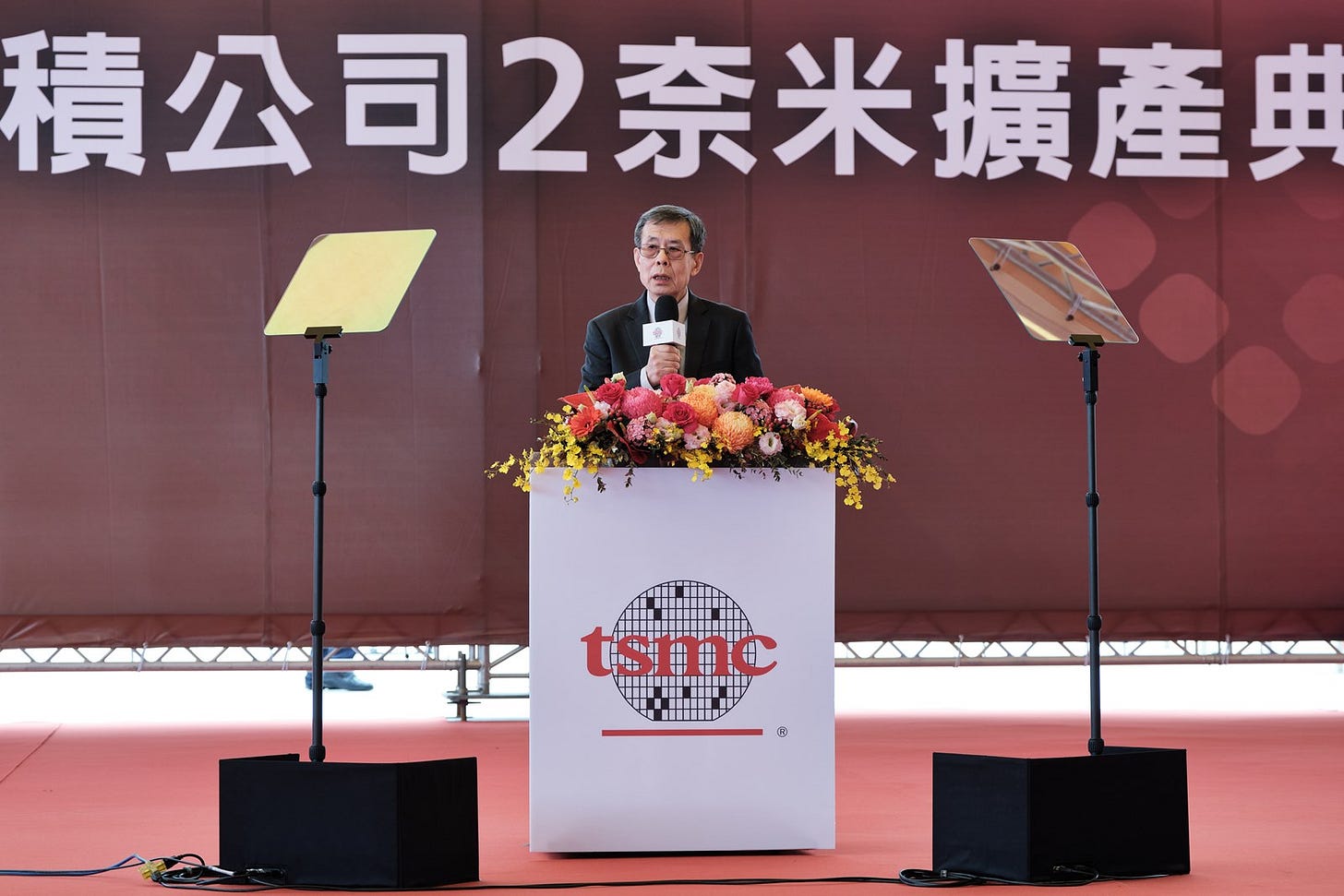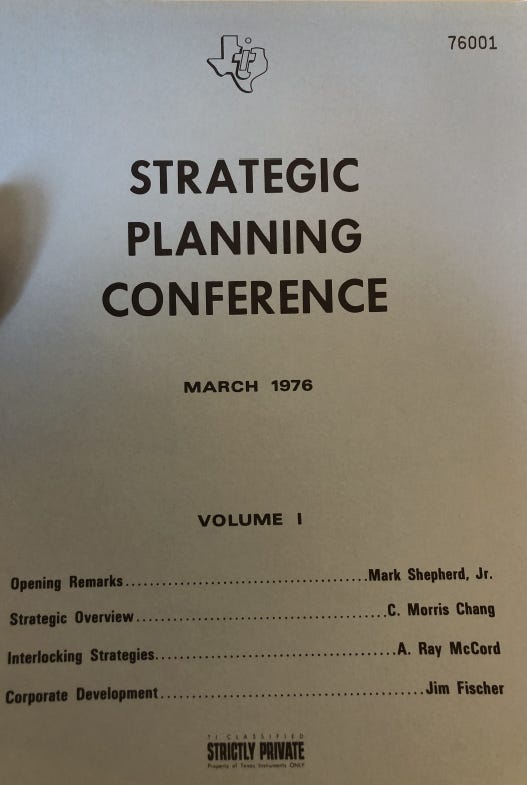Spring Break Bonus: Intel vs. TSMC 2nm War Begins! Plus UMC–GlobalFoundries Merger Rumors
Liang-rong Chen
Hello everyone,
It’s spring break in Taiwan this week, but the semiconductor world remains as lively as ever.
GlobalFoundries Courts UMC (Again)
Late Monday night, Nikkei Asia broke an exclusive: GlobalFoundries (GF), the world’s fifth-largest contract chipmaker, has approached UMC—the fourth-largest—with a merger proposal.
This news briefly sent UMC shares soaring the next day. However, after UMC issued a statement saying that “no merger proposal is under consideration,” the stock gains quickly narrowed.
A person familiar with the matter revealed that this was actually GlobalFoundries’ second attempt at a proposal. “UMC isn’t very interested, so nothing’s even close to taking shape,” the source said.
One angle that’s been generating buzz among TV pundits and certain media outlets is the idea that the U.S. government is quietly pulling the strings behind the deal—following the logic behind TSMC’s expanded investments in the U.S., or even rumors of acquiring Intel’s foundry business.
In this view, after building a “TSMC America,” Washington is now aiming to create a “UMC America” focused on mature process nodes.
But that’s likely pure speculation.
The U.S. doesn’t lack mature-node capacity, and GlobalFoundries—now majority-owned by Abu Dhabi’s Mubadala Investment Company—has only one-third of its capacity in the U.S. It’s unlikely to be seen as a strategic “national champion” by Washington.
Intel and TSMC Face Off at 2nm and the Return of the King?
The more pivotal news this week: the long-awaited 2nm showdown has finally begun.
On Monday, TSMC held an expansion ceremony at its Kaohsiung fab. Executive VP and Co-COO Y.P. Chin(秦永沛) announced that Phase 1 (P1) of the site will begin volume production of 2nm chips in the second half of 2025.

Just hours later in Las Vegas, Intel’s new CEO Lip-Bu Tan(陳立武)gave his first major address at the company’s annual customer and partner event. He announced that Intel’s Panther Lake processor—its first to use the in-house 18A process—would launch later this year.
While 18A is nominally a 1.8nm node, Bernstein research shows its SRAM density is comparable to TSMC’s 2nm. In other words, they are neck and neck technologically.
This could mark the first time since TSMC overtook Intel at 7nm in 2018 that Intel has caught up—or even pulled ahead—on process leadership.
Intel’s 18A is also the first to implement Backside Power Delivery Network (BSPDN), relocating power rails from the top of the chip to the bottom, enabling higher power efficiency and density. TSMC’s equivalent, 16A, won’t arrive until 2026 at the earliest.
If successful, Intel won’t just restore its image—it could spark a series of ripple effects.
For one, Intel is currently outsourcing 3nm chips for laptops and desktops to TSMC. With 18A, it could bring those designs back in-house, softening TSMC’s 2026 growth outlook.
TSMC’s first 2nm client will be AMD (Apple won’t use 2nm until the 2026 iPhone). AMD’s Zen 6-based 2nm processors for PCs and laptops are slated to launch that same year—setting the stage for a direct clash with Intel’s 18A chips.
Can Intel finally mount its long-awaited comeback? Or, as many in the industry expect, will it once again fall behind schedule—pushing its foundry business further into a dead end?
The Hidden Power of the Experience Curve
TSMC might actually prefer Intel’s success—at least geopolitically.
As former TSMC R&D director (also a one-time Intel advisor) Konrad Young(楊光磊)said on my podcast: “Let the Americans take the lead. We Taiwanese just quietly make money.”
If Intel’s 18A triumphs and advanced semiconductor manufacturing returns to U.S. soil, it would ease the political pressure on TSMC considerably.
Still, anyone betting on Intel’s long-term resurgence may be getting ahead of themselves.
This feels eerily similar to the 14nm vs. 16nm saga a decade ago. Samsung struck first with its 14nm launch and briefly pressured TSMC. But TSMC quickly rolled out its second- and third-generation 16nm processes, reclaimed market share, and decisively pushed Samsung back—leaving it to stumble through several generations afterward.
Why has TSMC become almost invincible in recent years? Why do competitors’ best punches never seem to land?
The secret lies in a strategy paper written nearly 50 years ago by TSMC founder Morris Chang during a management meeting at Texas Instruments (TI). That memo is what gave him the confidence to later declare: “My strategy is to make my competitors despair.”
It’s all in a piece I wrote two years ago—one of my favorites—and it remains surprisingly relevant for decoding today’s semiconductor power plays. So during this warm, blooming spring break, I’d like to share it with you.
Morris Chang Found the Secret to Winning in Semiconductors—Even Before TSMC Was Born: A Curve of Despair
I used to mention that Chris Miller, author of Chip War, had discovered a document in Texas Instruments’ (TI) historical archives. It proved that Morris Chang, founder of TSMC, had already formed the preliminary idea of the foundry model while still working at TI.
Miller sent me the scanned images of that document.
It was a 16-page report presented by 45-year-old Morris Chang, then General Manager of TI’s Semiconductor Group, at a strategic planning meeting in March 1976.
The content was classic Chang—logically rigorous, vividly argued, supported by numerous charts, and bold in its conclusions.
Citing breakthroughs in multiple process technologies and the rapid takeoff of the market, he predicted that semiconductors were entering a golden decade. He strongly advocated that TI invest heavily in advanced technologies, not only for internal use in its own electronics products, but also to sell to the external market—marking the first step toward the foundry model.
Reading it now evokes a mix of admiration and regret.
At the time, TI had already made what could be considered one of the most foolish decisions in tech history: shifting its focus from semiconductors to consumer electronics, a move that led to a rapid decline in the following years.
Chang, delivering his report at the meeting, must have felt like a loyal minister powerless to reverse the course of a collapsing empire—yet he still held out hope of turning the tide.
We all know how the story ends: the proposal was shelved, and Chang’s once-smooth career took a sharp turn, eventually leading him to Taiwan a few years later.
He Always Believed in the Experience Curve
One section of the document caught my eye: it argued that semiconductor costs would decline along an “experience curve.”
This reminded me of a speech Morris Chang gave in 2021 at the 20th anniversary of the Monte Jade Science & Technology Association of Taiwan.
In that talk, he emphasized that the learning curve was “the foundation of many of [his] strategies.” He gave three examples, spanning different decades and companies:
While at TI, even when a popular product had captured 50% market share, he insisted on cutting prices every quarter—ruthlessly squeezing out competitors.
Former GE CEO Jack Welch’s legendary strategy: if a business unit couldn’t become one of the top two players in its industry within five years, GE would exit the market.
Intel CEO Pat Gelsinger’s bold move to enter the foundry business and take on TSMC.
Chang said that all three strategic decisions were rooted in the “learning curve” theory, but didn’t elaborate further. I believe many in the audience, like me, were left somewhat puzzled at the time.
Now, reading this document that he personally authored more than 40 years ago, the concept finally clicked into place for me.
As it turns out, the “learning curve” he referred to was none other than the well-known experience curve theory developed by Boston Consulting Group (BCG)—which in its early days was also called the learning curve.
This theory, proposed by BCG founder Bruce Henderson in 1966, states that as experience accumulates, the unit cost of production tends to fall. Typically, with every doubling of output, unit costs drop by 20% to 30%.
The theory was wildly popular in the U.S. during the 1970s, and TI was one of its earliest corporate adopters.
According to The Lords of Strategy, a book by former Fortune Managing Editor Walter Kiechel, TI turned to the then-newly founded BCG in the early 1970s to develop its pricing strategy.
BCG assembled a dream team that included future stars like the future dean of Harvard Business School and the future head of Citibank’s investment banking division. Leading the team was Bill Bain, who would later go on to found Bain & Company—making it one of the “Big Three” consulting firms alongside McKinsey and BCG.
TI’s main point of contact for the project was none other than Morris Chang. According to his 2007 oral history interview at the Computer History Museum in the U.S., he was deeply involved in the project and provided large volumes of data. “This was a very cutting-edge approach in the semiconductor industry,” he recalled.
Using Price Advantage to Capture Market Share
The BCG team meticulously calculated the individual experience curves for 50 distinct semiconductor process steps and developed an “experience curve pricing model” to help Morris Chang forecast future cost declines. This enabled him to set aggressive prices and undercut competitors, quickly gaining market share for TI’s flagship products.
As a result, he was promoted to head of the Semiconductor Group, becoming the highest-ranking Chinese executive in American corporate history at the time.
This major victory was the first example cited in his speech at the Monte Jade event. As for the second—the General Electric case—Chang explained that Jack Welch was also a firm believer in the experience curve. One of the essential conditions for successfully applying the theory is to achieve a high market share, which is why GE insisted on exiting any business where it couldn’t be in the top two.
This also explains the third example: Intel’s entry into the foundry business. To a certain extent, it was about increasing market share as well—more precisely, gaining share in the most advanced process technologies.
That line of thinking is remarkably similar to Chang’s 1976 proposal. At the time, he argued that for TI to gain high market share in advanced process nodes, it would need to sell to external customers. The underlying guiding principle? The experience curve.
Boosting Yields Through Wafer Volume
A senior executive at a major semiconductor company once told me that the key to improving yield isn’t time—it’s wafer volume. Many yield issues only become apparent after running tens of thousands of wafers through production.
For nodes below 7 nanometers, each wafer costs upward of $10,000. At such early stages, when yields may be as low as 20% or 30%, having major customers like Apple and Nvidia—willing to spend heavily and rush to become early adopters—is absolutely critical for TSMC.
Even if Intel and Samsung possess technology on par with TSMC, if they rely solely on their own products to ramp up production of advanced nodes, the total wafer volume will be far lower than TSMC’s broad customer base.
According to the experience curve theory, it would take them several times longer than TSMC to reach the same yield levels—by which time, they would have already missed the market window.
This is one of the foundry model’s unspoken, hidden advantages.
Read more here:
The Key Figure Behind TSMC’s U.S. Expansion: TSMC’s Shohei Ohtani, Ying-Lang Wang
TSMC Taking Over Intel’s Manufacturing? A High-Profile Dinner and an Insider Clues





